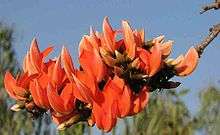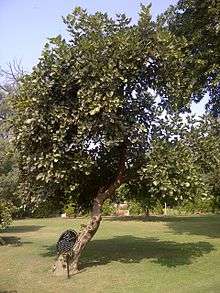Butea monosperma
| Butea monosperma | |
|---|---|
 | |
| In Bangalore, India | |
| Scientific classification | |
| Kingdom: | Plantae |
| (unranked): | Angiosperms |
| (unranked): | Eudicots |
| (unranked): | Rosids |
| Order: | Fabales |
| Family: | Fabaceae |
| Genus: | Butea |
| Species: | B. monosperma |
| Binomial name | |
| Butea monosperma (Lam.) Taub. | |
| Synonyms | |
|
Butea frondosa Roxb. ex Willd. | |
_flowers_in_Kolkata_I_IMG_4225.jpg)



Butea monosperma is a species of Butea native to tropical and sub-tropical parts of the Indian Subcontinent and Southeast Asia, ranging across India, Bangladesh, Nepal, Sri Lanka, Myanmar, Thailand, Laos, Cambodia, Vietnam, Malaysia, and western Indonesia.[1] Common names include flame-of-the-forest and bastard teak.[1]
It is a medium-sized dry season-deciduous tree, growing to 15 m (49 ft) tall. It is a slow growing tree, young trees have a growth rate of a few feet per year. The leaves are pinnate, with an 8–16 cm (3.1–6.3 in) petiole and three leaflets, each leaflet 10–20 cm (3.9–7.9 in) long. The flowers are 2.5 cm (0.98 in) long, bright orange-red, and produced in racemes up to 15 cm (5.9 in) long. The fruit is a pod 15–20 cm (5.9–7.9 in) long and 4–5 cm (1.6–2.0 in) broad.[2]
In West Bengal, it is associated with spring, especially through the poems and songs of Nobel Laureate Rabindranath Tagore, who likened its bright orange flame-like flower to fire. In Santiniketan, where Tagore lived, this flower has become an indispensable part of the celebration of spring. The plant has lent its name to the town of Palashi, famous for the historic Battle of Plassey fought there.
In the state of Jharkhand Palash is associated with the folk tradition. Many folk literary expressions describe palash as the forest fire. The beauty of dry deciduous forests of Jharkhand reach their height when most trees have fallen their leaves and Palash is in its full bloom. Palash is also the State Flower of Jharkhand.
It is said that the tree is a form of Agni, God of Fire. It was a punishment given to Him by Goddess Parvati for disturbing Her and Lord Shiva's privacy. In Telangana, these flowers are specially used in the worship of Lord Shiva on occasion of Shivratri. In Telugu, this tree is called Modugu chettu.
In Kerala, this is called 'plasu' and 'chamata'. Chamata is the vernacular version of Sanskrit word 'Samidha', small piece of wood that is used for 'agnihotra' or fire ritual. In most of the old namboodiri (Kerala Brahmin) houses, one can find this tree because this is widely used for their fire ritual.
In Theravada Buddhism, Butea monosperma is said to have used as the tree for achieved enlightenment, or Bodhi by second Lord Buddha called "Medhankara - මේධංකර". The plant is known as කෑල in Sinhala.
History
Historically, dhak forests covered much of the doab area between the Ganges and Yamuna, but these were cleared for agriculture in the early 19th century as the English East India Company increased tax demands on the peasants.[3]
Use
It is used for timber, resin, fodder, medicine, and dye. The wood is dirty white and soft and, being durable under water, is used for well-curbs and water scoops. Good charcoal can be obtained from it. The leaves are usually very leathery and not eaten by cattle. The leaves are used by street food sellers to serve food placed on the leaves.

Usage in leather
The gum is known as Bengal Kino and is considered valuable by druggists because of its astringent qualities and by leather workers because of its tannin.[4]
Culinary use
The gum from the tree, called kamarkas in Hindi, is used in certain food dishes.
Patravali plate
In villages of many parts of India, for example in Maharashtra, this tree provides leaves that are used either with many pieced together or singly (only in case of a banana leaf) to make a leaf-plate for serving a meal over, and for example a would-be son-in-law was in older times (until a century ago) was tested on his dexterity in making this plate and bowl (for serving more liquid parts of the meal such as daal or stew) before being declared acceptable by the father-in-law-to-be.
Dye
The flowers are used to prepare a traditional Holi colour. It is also used as a dyeing color for fabric.
Pesticide
Mosquitoes are attracted by the smell and color of the flower. Eggs that are laid into the liquid within the flower will never hatch. Mosquitoes that touch the fluid can get trapped in it.
Literature
This tree has been used in Punjabi literature extensively. Great Punjabi poet Harinder Singh Mahboob has used it as a symbol in his poetry:
ਤਪਦੇ ਕੇਸੂ ਛੂਹਣ ਲਈ
ਵਲ ਰੋਹੀਆਂ ਜਾਵੇਂ,
ਮੰਗੂ ਮੇਰੇ ਦੂਰ ਨੇ
ਕਿਸੇ ਬ੍ਰਿਛ ਦੀ ਛਾਂਵੇਂ,
ਭੇਦ ਪੁਰਾਣਾ ਕਦੋਂ ਦਾ, ਵਲ ਪੱਤਣਾਂ ਚਾਇਆ,
ਮਨ ਪਰਦੇਸੀ ਜੇ ਥੀਐ, ਸਭ ਦੇਸ ਪਰਾਇਆ।
-ਝਨਾਂ ਦੀ ਰਾਤ (੩੯੧)
Tapade kesū chūhaṇa lasī
vala rohīāṃ jāveṃ,
maṃgū mere dūra ne
kise bricha dī chāṃveṃ,
bheda purāṇā kadoṃ dā, vala pattaṇāṃ cāiā,
mana paradesī je thīai, sabha desa parāiā.
-Jhanāṃ dī rāta (391)
In Rudyard Kipling's short story Beyond the Pale (contained in Plain Tales from the Hills, published in 1888), he says of the dhak: 'The flower of the dhak means diversely 'desire', 'come', 'write', or 'danger', according to the other things with it.'
The first sloka of sukla yajurveda speaks about Palasa tree. The Palasa tree branch is cut & trimmed by the Adhvaryu priest who performs the practical part of sacrifice, the day before New or the full moon, uses it to drive the calves away from cows whose milk is to form part of the offerings of the next day's special ceremony.
Other names
Flame of the Forest Bastard Teak, Parrot Tree (Eng.), Chichra tesu, desuka jhad, dhaak, palaash, chalcha, kankrei (Hindi), PaLash (पळस) (Marathi), Palashpapra (Urdu), Muthuga (ಮುತ್ತುಗ) (Kannada.), Kinshuk, Polash, Polashi (Beng.), Pauk (Burmese), Polash (Polax) in Assamese, Porasum, Parasu (Tam.), Muriku, Shamata (Mal.), Modugu(మోదుగ) (Telugu), Khakda (Guj.), Kela (Sinh.),[4] Ploso (Javanese), Palash (Odia)
In Sanskrit also the flower is extensively used as a symbol of the arrival of spring and the colour of love. Jayadeva in the Gita Govindam compares these blossoms to the red nails of Kamadeva or Cupid, with which he wounds the hearts of lovers. The imagery is all the more appropriate as the blossoms are compared to a net of kimsuka flowers(किंशुकजाले). In a completely leafless tree, the blossoms look like a net.
मृगमदसौरभरभसवशंवदनवदलमालतमाले। युवजनहृदयविदारणमनसिजनखरुचिकिंशुकजाले॥
The above stanza is translated here by Barbara Stoller Miller, for Kimsuka blossoms, she uses the common name "Flame tree petals":
Tamala tree's fresh leaves absorb strong scent of deer musk. Flame tree petals, shining nails of love, tear at young hearts.
(Gita Govinda of Jayadeva, Love Song of the Dark Lord, Motilal Banarsidass)
References
- 1 2 3 "Butea monosperma (Lam.) Taub.". Germplasm Resources Information Network. United States Department of Agriculture. 2006-05-18. Retrieved 2009-10-24.
- ↑ Huxley, A., ed. (1992). New RHS Dictionary of Gardening. Macmillan ISBN 0-333-47494-5.
- ↑ Mann, Michael, Ecological Change in North India: Deforestation and Agrarian Distress in the Ganga-Yamuna Doab 1800-1850, in "Nature and the Orient" edited by Grove, Damodaran and Sangwan
- 1 2 Cowen, D. V. (1984). Flowering Trees and Shrubs in India, Sixth Edition. Bombay: THACKER and Co. Ltd. p. 3.
| Wikimedia Commons has media related to Butea monosperma. |